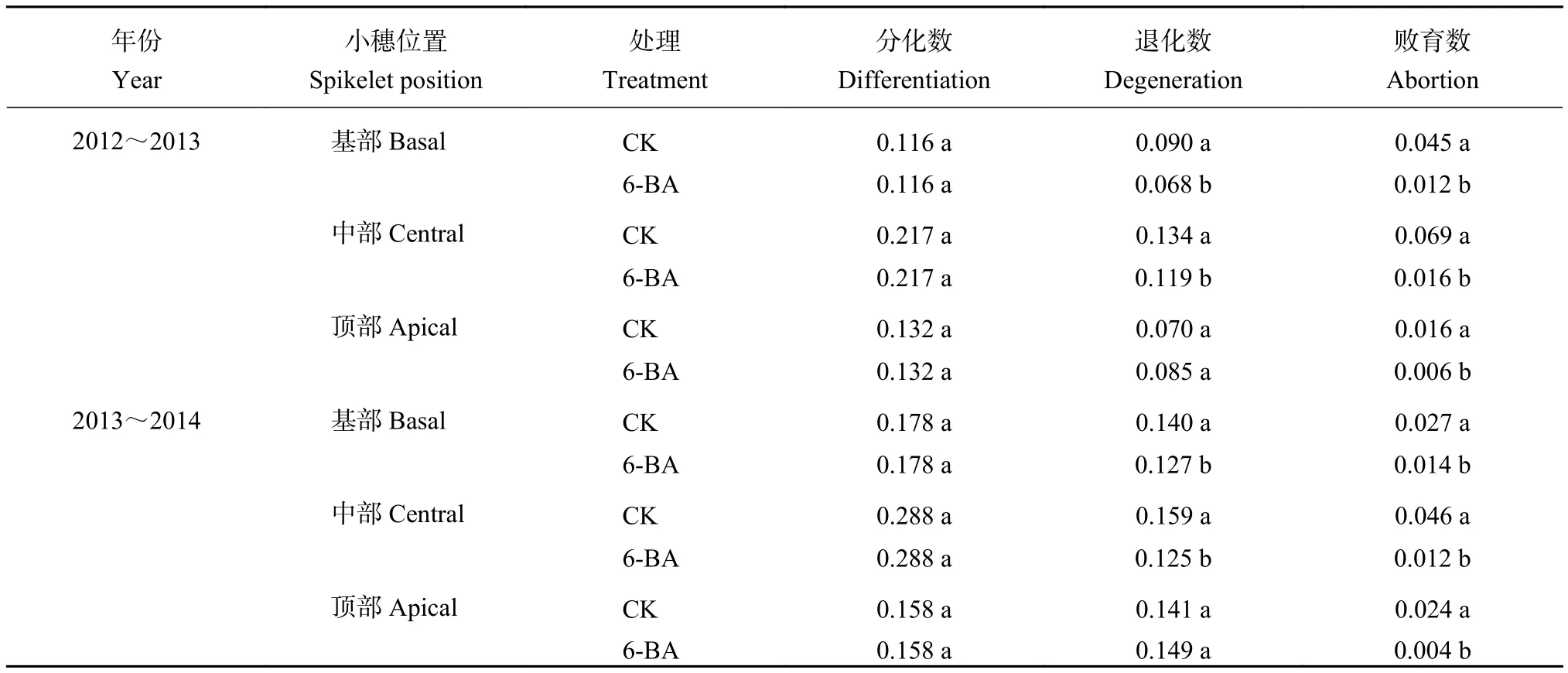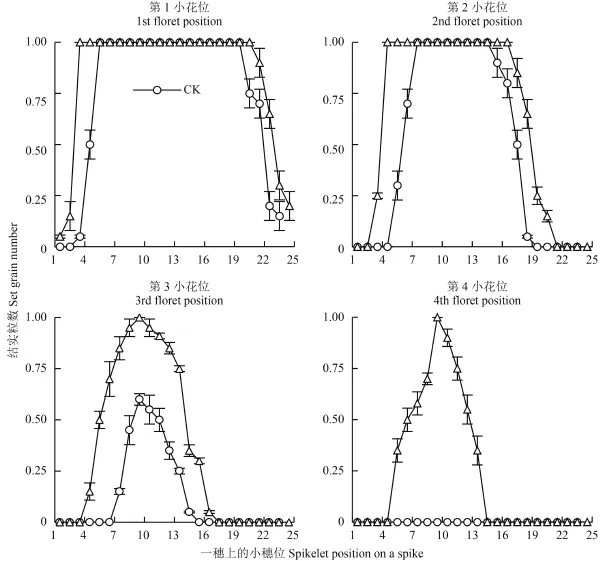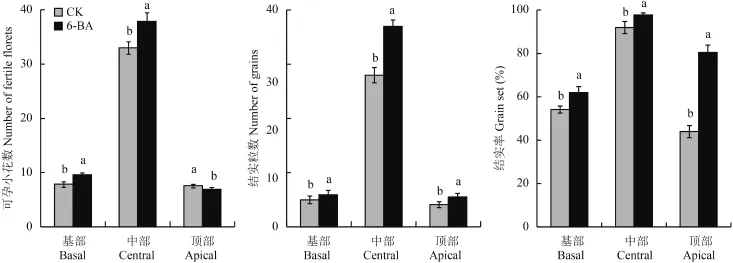冬小麦小花发育及结实特性对叶面喷 6-BA 的响应
郑春风,任伟,朱云集,张玉亭,孙克刚,杜君,张运红,和爱玲
冬小麦小花发育及结实特性对叶面喷 6-BA 的响应
郑春风1,任伟2*,朱云集3,张玉亭1,孙克刚1,杜君1,张运红1,和爱玲1
(1 河南省农业科学院植物营养与资源环境研究所/河南农业生态与环境重点实验室,河南郑州 450002;2 河南省农业科学院小麦研究所,河南郑州 450002;3 河南农业大学/国家小麦工程技术研究中心,河南郑州 450002)
【目的】通过小花发育后期叶面喷细胞分裂素 6-苄氨基腺嘌呤 (6-BA),探讨外源 6-BA 对小麦小花发育及结实成粒的调控效应,以期为增加小麦穗粒数、提高产量调控技术的研究提供参考。【方法】试验于2012~2014 年在河南农业大学科教示范园区 (34°86′N, 113°59′E) 进行,以当前主推的半冬性品种豫麦 49-198 为供试材料,在拔节后 25 d 叶面喷清水 (对照 CK)、6-苄氨基腺嘌呤 (6-BA),观察记载不同小穗位小花发育的动态变化及形态特征,按常规考种法记载不同小穗位 (基部、中部和顶部) 结实粒数、每小穗结实粒数和每小穗不同花位结实粒数。【结果】喷 6-BA 处理麦穗基部、中部、顶部小穗位的可孕小花数显著高于对照,其可孕小花的结实率分别提高 8.4%、15.1% 和 10.6%。进一步分析可知,喷 6-BA 处理抑制了基部和中部小穗小花的退化速率及可孕小花的败育速率,其中基部小穗位的小花退化速率降低 24.4%,可孕小花败育速率降低 73.0%;中部小穗位小花的退化速率降低 14.7%,可孕小花败育速率降低 76.0%;而且顶部小穗可孕小花的败育速率较对照降低 61.3%,最终使顶部小穗的结实率亦显著提高。喷 6-BA 处理还可显著促进不同小穗位的不同花位小花结实,尤其对促进第 3、4 花位弱势小花成粒效果显著。【结论】在冬小麦小花退化高峰之前 (拔节后 25 d),采取叶面喷外源激素 6-BA,可明显降低基部小穗和中部小穗小花的退化速率与可孕小花的败育速率。另外,喷 6-BA处理还可抑制顶部小穗可孕小花的败育速率,从而提高单穗的可孕花结实率,获得较高的最终结实粒数。
冬小麦;叶面喷 6-BA;小花发育;结实特性
小麦是我国主要粮食作物之一,在粮食安全战略中具有举足轻重的地位[1]。在目前中高产水平条件下,进一步提高小麦产量,应在稳定适宜穗数的基础上,把增加穗粒数和提高粒重作为突破口[2–4]。但由于受品种遗传特性和环境条件的制约,粒重增加的幅度相对有限,提高穗粒数应成为进一步提高小麦产量的关键[5]。小麦穗粒数的形成是小花分化、发育、退化和结实等一系列生理过程的最终体现[6],探明不同栽培调控条件下小花分化和退化的动态特征及穗粒数形成规律,对于深化小麦产量生理的研究和提高穗粒数,具有十分重要的理论和实际意义。6-BA是第一个人工合成的细胞分裂素,在促进细胞分化、植株从营养生长向生殖生长转化及诱导植物物质积累与调运方面有重要作用[7]。细胞分裂素具有向其作用的部位调运营养的能力[8]。王志敏[9]用 6-BA处理麦穗,发现处理穗的还原糖含量和果聚糖含量高于对照穗,蔗糖转化酶活性和酸性转化酶活性也比对照有所增加。孙振元等[10]证实 6-BA 处理叶或穗均影响营养器官及穗的氮素吸收、分配和再分配。杨东清等[11]研究认为,在小麦盛花后期喷施 6-BA 能显著提高花后旗叶叶绿素含量,延缓叶片衰老。通过对小麦小花发育与退化过程中可孕花与不孕花的内源植物激素含量变化动态的研究,王兆龙等[12]认为,小花两极分化过程中内源激素平衡的剧烈变化,可能是启动小花退化的一个重要原因。前人有关 6-BA 调控作物的细胞分裂、碳氮代谢和营养物质运输的研究已有较多报道[13],然而关于 6-BA 调控冬小麦小花发育与退化及结实特性的研究少见报道。本研究拟通过小花发育后期叶面喷施 6-BA,探究其对可孕小花发育和结实特性的影响,以期为通过调控技术增加小麦穗粒数而提高产量提供参考。
1 材料与方法
1.1 试验材料与设计
本研究于 2012~2014 年在河南农业大学科教示范园区 (34°86′N, 113°59′E) 进行田间试验,土壤质地为壤土,0—20 cm 土层有机质含量为 10.6 g/kg、全氮 0.9 g/kg、碱解氮 82.1 mg/kg、速效磷 25.6 mg/kg、速效钾 124.5 mg/kg、有效硼 0.41 mg/kg。总施氮量 146 kg/hm2(尿素,含 N 46%),50% 于播前基施,其余 50% 于拔节期追施。播前每公顷施磷肥(P2O5) 150 kg、钾肥 (K2O) 120 kg。以当前主推的半冬性品种豫麦 49-198 为供试材料,两年试验材料均于 10 月 8 日播种,基本苗为 2.25 × 106株/hm2,行距为 20 cm,试验田栽培管理同一般高产田。在拔节后 25 d (小花退化后期),败育 (完善小花部分死亡不成粒时期) 前叶面喷清水 (CK)、6-BA (10 mg/L),均以叶面表层形成一层水雾但不下滴为准,每处理小区面积为 20 m2,重复 3 次。
1.2 测定项目与方法
自小麦 3 叶期开始取样,每隔 7 d 取样 1 次,每小区选择生长均匀一致的小麦植株 5 株 (每处理共计15 株),在 EMZ-TR 解剖镜下观察记载主茎幼穗分化进程,并观察记载分化小穗数、小花数及幼穗分化各阶段特征。自喷施 6-BA 和清水后,每隔 3 d 取样观察一次,至开花后 5 d 结束,以有完整绿色花药的小花为完善小花。
播后累积生长度日 GDD = [(Tmax+ Tmin)/2] – Tb
式中:Tmax为最高温度,Tmin为最低温度,Tb为基础发育温度。
不同穗位小穗划分:基部穗位小穗 (1~5 小穗)、中部穗位小穗 (除基部和顶部小穗以外的小穗)、顶部穗位小穗 (顶部 5 个小穗)。
产量及其构成因素:成熟期每小区随机取 20株,按常规考种法记载不同小穗位 (基部、中部和顶部) 结实粒数,每小穗结实粒数和每小穗不同小花位结实粒数,实收 5 m2计产。
1.3 数据统计分析
采用 Microsoft Excel 2003 和 SPSS 17.0 软件对2012~2013 和 2013~2014 两年数据进行处理分析及绘图。
2 结果与分析
2.1 喷 6-BA 对不同小穗位小花原基发育动态变化的影响
由于喷 6-BA 处理于拔节后 25 d 进行,所以对照与处理的不同穗位小花在前期分化阶段发育相同。两年观察结果表明,适期播种小麦主茎小花数随播后 GDD 的变化分别符合上升曲线、速降直线、缓降直线动态模式,并且不同小穗位小花数的变化趋势相似。中部小花分化高峰值最大,每穗约 80个,表明中部穗位小花发育强度较大,总小花数多。由图 1 看出,喷 6-BA 处理在基部和中部小穗位的可孕小花数显著高于对照,顶部小穗位的可孕小花数略高于对照。
2.2 喷 6-BA 对不同小穗位小花原基发育速率的影响
由表 1 可看出,中部穗位小花分化速率快于基部和顶部,以 2012~2013 年为例,单位 GDD 分化小穗小花数为 0.22 个。在基部、中部、顶部小穗位,喷 6-BA 处理单位 GDD 小花退化数分别为0.068、0.119、0.085 个,相应的对照为 0.090、0.134、0.070 个,小花退化数较对照基部和中部分别降低 24.4%、14.7%,而顶部增加了 21.4%。
基部、中部和顶部,喷 6-BA 处理的单位 GDD可孕小花败育数为 0.012、0.016、0.006 个,对照分别为 0.049、0.069、0.006 个,较对照分别降低73.0%、76.0% 和 61.3%。
2.3 喷 6-BA 对冬小麦不同小穗位小花结实特性的影响

图1 喷施 6-BA 处理和对照小麦不同小穗位小花原基在发育过程中的数量Fig. 1 Floret primordium amounts of basal, central and apical spikelet of wheat during the development under spraying 6-BA and control treatments

表1 喷施 6-BA 小麦不同位置小穗的小花原基分化、退化与败育数 [No./(spikelet·GDD)]Table1 The differentiation, degeneration and infertility number of floret primordia in different parts of a spikelet sprayed with 6-BA

图2 小麦主茎穗上不同位小穗的平均结实粒数Fig. 2 The average grain number in each spikelet of the main-shoot spike[注(Note):柱上不同字母表示处理间差异达 0.05 显著水平Different lowercase letters above the bars indicate significant differences between the treatments at P< 0.05.]
2.3.1 不同小穗位的结实粒数 由图 2 可看出,喷6-BA 处理的不同小穗位平均结实粒数较对照高。两者均在第 9 小穗时平均结实粒数达到最大,并且喷6-BA 处理的结实粒数显著高于对照。其中,喷 6-BA处理从第 2 小穗开始结实,而对照从第 3 小穗开始。喷 6-BA 处理结实总小穗数为 23 个,且第 23 个小穗的平均结实粒数为 0.2 个,对照结实总小穗数为21 个,第 21 个小穗的平均结实粒数为 0.4 个,两年试验结果基本一致。
2.3.2 不同小穗位不同小花位的结实粒数 由图 3 可看出,喷 6-BA 处理和对照的主茎穗各小穗位不同小花位结实粒数均表现为第 1 花位结实粒数最多,即Floret 1 > Floret 2 > Floret 3 > Floret 4。喷 6-BA 处理的第 1 小花位平均结实粒数达到 1 的小穗数显著多于对照,表现为 6-BA = 19 > CK = 14。第 2、3 和 4小花位平均结实粒数达到 1 的小穗数与对照相比表现出相同的趋势为 6-BA > CK,且 2 处理平均结实粒数在第 3 和 4 小花位差异更突出。
2.3.3 不同小穗位的可孕小花数、结实粒数、可孕花结实率 由图 4 可看出,喷 6-BA 和对照 2 种处理不同小穗位的平均可孕花数表现为中部小穗位最多,为 30~40 个,其次是基部穗位,为 8~10 个,顶部最少,为 6~7 个。结实粒数也是中部穗最多(25~35 个),其次为基部穗 (4.2~6 个),最少是顶部穗 (4~5.5 个)。中部小穗位和基部小穗位喷 6-BA 处理的可孕小花数、结实粒数和可孕花结实率均多于对照,其中,可孕花结实率较对照分别提高了 15.06%和 8.35%;顶部小穗位喷 6-BA 处理的结实粒数和可孕花结实率高于对照,且可孕花结实率较对照提高了 10.55%,然而可孕小花数却低于对照。

图3 小麦主茎穗上各小穗不同小花位的平均结实粒数Fig. 3 Average grain amounts in different floret position at each spikelet position on the main-shoot spike of wheat

图4 小麦主茎穗上不同部位小穗的可孕小花数、结实粒数和结实率Fig. 4 Fertile floret number, grain number and grain set percentage in basal, central and apical spikelet on the main-shoot spike of wheat[注(Note):柱上不同字母表示处理间差异达 0.05 显著水平Different lowercase letters above the bars indicate significant differences between the treatments at P< 0.05.]
2.4 喷6-BA对产量及产量构成因素的影响
由于 2014 年春季气温较高,开花较早,籽粒灌浆期较长,2013~2014 年度穗粒数低于 2012~2013年度,但千粒重高于上年度。但两年气候条件下,从产量构成因素分析,喷 6-BA 处理与对照在穗粒数和产量上均表现为 6-BA > CK,且 2 处理之间差异达到显著水平,在千粒重上也表现出 6-BA > CK,但差异不明显。由此表明,在小花发育后期,喷外源 6-BA 主要是通过提高其穗粒数来提高产量,对千粒重的影响差异不明显 (表 2)。

表2 喷 6-BA 和对照冬小麦的产量和产量构成因素Table2 Yield components and grain yields of winter wheat under the spraying 6-BA and control treatments
3 讨论
小麦穗粒数是决定产量的关键因素,也是变异性最大的产量因子[14–15]。朱云集等[16]曾指出,在我国黄淮麦区,穗粒数少已成为提高产量的最小因子,即限制小麦籽粒产量提高的短板。就现有推广的大部分品种来说,若在产量构成三因素成穗数、穗粒数和千粒重各增加 1 个单位,以穗粒数对产量贡献的绝对值最高。崔金梅等[17]经过长达数十年的研究,证明我国河南省麦区的小麦幼穗分化期较长,仅小花发育过程又分为小花分化、退化和可孕花败育 3 个阶段 (长达 60 d 左右),而且单穗分化总小花数较多(150 朵以上),小花发育过程中的温光条件、营养器官的生长状况、养分与水分供应状况等均影响其发育与成粒。在小花退化高峰前即小花两极分化之前采取调控措施,能减少小花退化,增加穗粒数[17–19]。小花发育的完善程度与最终粒数的形成关系密切,可孕小花的发育直接影响穗粒数的多少,在完善小花发育成粒阶段采取调控措施,降低可孕小花的败育率,应是提高穗粒数的关键[20]。本研究结果表明,在拔节后 25 d (小花败育之前) 叶面喷外源 6-BA,使小麦穗基部、中部和顶部小穗位的可孕小花败育速率与对照相比分别降低 73.0%、76.0% 和 61.3%,可孕花结实率分别提高 8.4%、15.1% 和 10.6%。
植物激素在小花发育和退化过程中起着重要的调控作用,外源植物激素玉米素对小花发育和结实有调控效应,不同发育时期的小花对植物激素的调控响应不同[21]。对于同一小穗的小花来说,激素对上位小花的调节作用大于其对下位小花的调节作用[22]。由于解剖结构或营养供应的差异,下位小花 (小穗基部的第 1、2 位小花) 发育优势大于上位小花,顶端和基部小穗发育劣于中部小穗,常为不孕小穗[17]。激素对小花分化发育的调节作用依赖于发育时期,不同时期的外源激素处理对小麦小花发育产生不同的调控效应。倪英丽[23]研究表明,在药隔形成期外源玉米素处理可显著增加结实小花和穗粒数。本研究结果发现,在完善小花败育之前,外源 6-BA 可促进不同小穗位不同小花位小花结实,尤其对促进顶部弱势小穗位小穗和第 3、4 弱势花位小花结实成粒效果显著。由此推测,在拔节后期,叶面喷外源激素 6-BA可能调控了小花发育过程中叶片和幼穗内源激素水平的变化,或改变了麦穗不同部位同化物的供应与分配,从而有利于弱势小穗和小花的发育与结实,其内在的生理机制需进行进一步的探究。
4 结论
在冬小麦小花退化高峰和败育开始之前 (拔节后25 d),采取叶面喷外源激素 6-BA (10 mg/L),可明显降低基部小穗和中部小穗小花的退化速率与可孕小花的败育速率。另外,喷 6-BA 处理还可抑制顶部小穗可孕小花的败育速率,从而提高单穗的可孕花结实率,获得较高的最终结实粒数。
参 考 文 献:
[1]于振文, 田奇卓, 潘庆民, 等. 黄淮麦区冬小麦超高产栽培的理论与实践[J]. 作物学报, 2002, 28(5): 577–585. Yu ZW, Tian QZ, Pan QM, et al. Theory and practice on cultivation of super high yield of winter wheat in the wheat fields of rellow River and Huaihe River Districts[J]. Acta Agronomica Sinica, 2002, 28(5): 577–585.
[2]王兆龙, 曹卫星, 戴廷波. 小麦穗粒数形成的基因型差异及增粒途径分析[J]. 作物学报, 2001, 27(2): 236–242. Wang ZL, Cao WX, Dai TB. Genotypic differences in formation of kernel number per spike and analysis of improvement approaches in wheat[J]. Acta Agronomica Sinica, 2001, 27(2): 236–242.
[3]武文明, 李金才, 陈洪俭, 等. 氮肥运筹方式对孕穗期受渍冬小麦穗部结实特性与产量的影响[J]. 作物学报, 2011, 37(10): 1888–1896. Wu WM, Li JC, Chen HJ, et al. Effects of nitrogen fertilization on seed-setting characteristics of spike and grain yield in winter wheat under waterlogging at booting stage[J]. Acta Agronomica Sinica, 2011, 37(10): 1888–1896.
[4]刘漂, 陈庆富. 普通小麦正常小穗数与基部退化小穗数之间的相关性研究[J]. 贵州师范大学学报(自然科学版), 2009, 27(4): 1–5. Liu P, Chen QF. Relationships between normal and degraded spikelet numbers in common wheat[J]. Journal of Guizhou Normal University (Natural Sciences), 2009, 27(4): 1–5.
[5]朱云集, 郭天财, 王晨阳, 等. 两种穗型冬小麦品种产量形成特点及超高产关键栽培技术研究[J]. 麦类作物学报, 2006, 26(6): 82–86. Zhu YJ, Guo TC, Wang CY, et al. Study on yield formation of winter wheat cultivars with different spike types and their key cultivation techniques for super-high yield[J]. Journal of Triticeae Crops, 2006, 26(6): 82–86.
[6]王兆龙, 曹卫星, 戴廷波, 等. 不同穗型小麦品种小花发育与结实特性研究[J]. 南京农业大学学报, 2000, 23(4): 9–12. Wang ZL, Cao WX, Dai TB, et al. Characteristics of floret development and grain set in three wheat genotypes of different spike sizes[J]. Journal of Nanjing Agricultural University, 2000, 23(4): 9–12.
[7]Jameson PE, McWha JA, Wright GJ. Cytokinins and changes in their activity during the development of grains of wheat (Triticum aestivum L.)[J]. Journal of Plant Physiology, 1982, 106: 27–36.
[8]Borkovee V, Prochazka S. Pre-anthesis interaction of cytokinins and ABA in the transport of14C-sucrose to the ear of winter wheat (Triticum aestivum L.)[J]. Joumal of Agronomy and Crops Science, 1992, 169(4): 229–235.
[9]王志敏. 小麦穗粒数的调节[D]. 北京: 北京农业大学博士学位论文, 1994. Wang ZM. Regulation of grain number in wheat [D]. Beijing: PhD Dissertation, Beijing Agricultural University, 1994.
[10]孙振元, 韩碧文, 刘淑兰, 等. 小麦籽粒充实期氮素的吸收和再分配及6-苄氨基嘌呤的调节作用[J]. 植物生理学报, 1996, 22(3): 258–264. Sun ZY, Han BW, Liu SL, et al. Absorption and redistribution of nitrogen during grain-filling period of wheat and their regulation by 6-Benzylaminopurine[J]. Plant Physiology Journal, 1996, 22(3): 258–264.
[11]杨东清, 王振林, 尹燕枰, 等. 外源ABA和6-BA对不同持绿型小麦旗叶衰老的影响及其生理机制[J]. 作物学报, 2013, 39(6): 1096–1104. Yang DQ, Wang ZL, Yin YP, et al. Effects of exogenous ABA and 6-BA on flag leaf senescence in different types of stay-green wheat and relevant physiological mechanisms[J]. Acta Agronomica Sinica, 2013, 39(6): 1096–1104.
[12]王兆龙, 曹卫星, 戴廷波. 小麦小花两极分化中内源植物激素与糖氮含量的变化特征[J]. 作物学报, 2001, 27(4): 7–12. Wang ZL, Cao WX, Dai TB. Change of endogenous plant hormones and soluble sugars and proteins during floret development and degeneration in wheat[J]. Acta Agronomica Sinica, 2001, 27(4): 7–12.
[13]Rijavec T, Kovac M, Kladnik A, et al. A comparative study on the role of cytokinins in caryopsis development in the maize miniature1 seed mutant and its wild type[J]. Journal of Integrative Plant Biology, 2009, 51(9): 840–849.
[14]Fischer R. The importance of grain or kernel number in wheat: A reply to Sinclair and Jamieson[J]. Field Crops Research, 2008, 105: 15–21.
[15]Sinclair TR, Jamieson PD. Grain number, wheat yield, and bottling beer: An analysis[J]. Field Crops Research, 2006, 98: 60–67.
[16]朱云集, 崔金梅, 王晨阳, 等. 小麦不同生育时期施氮对穗花发育和产量的影响[J]. 中国农业科学, 2002, 35(11): 1325–1329. Zhu YJ, Cui JM, Wang CY, et al. Effects of nitrogen application at different wheat growth stages on floret development and grain yield of winter wheat[J]. Scientia Agricultura Sinica, 2002, 35(11): 1325–1329.
[17]崔金梅, 郭天财, 朱云集, 等. 小麦的穗[M]. 北京: 中国农业出版社, 2008: 284–286. Cui JM, Guo TC, Zhu YJ, et al. Spike of wheat [M]. Beijing: China Agricultural Press, 2008: 284–286.
[18]马元喜, 王晨阳, 朱云集. 协调小麦幼穗发育三个两极分化过程增加穗粒数[A]. 卢良恕. 中国小麦栽培研究新近展[C]. 北京: 农业出版社, 1991: 119–126. Ma YX, Wang CY, Zhu YJ. Coordinate three polarization process of young spike development to increase wheat grain number[A]. Lu L S. China’s wheat cultivation research progress [C]. Beijing: Agricultural Press, 1991: 119–126.
[19]王晨阳, 朱云集, 夏国军, 等. 氮肥后移对超高产小麦产量及生理特性的影响[J]. 作物学报, 1998, 24(6): 978–983. Wang CY, Zhu YJ, Xia GJ, et al. Effects application of nitrogen at later stage on grain yield and plant physiological characteristics of super-high-yielding winter wheat[J]. Acta Agronomica Sinica, 1998, 24(6): 978–983.
[20]朱云集, 崔金梅, 郭天财, 等. 河南省小麦生产发展中几个关键技术问题的商榷[J]. 河南农业科学, 2011, 40(8): 54–57. Zhu YJ, Cui JM, Guo TC, et al. Discussion of key technique problems in development of wheat production in Henan Province[J]. Journal of Henan Agricultural Sciences, 2011, 40(8): 54–57.
[21]王兆龙. 小花发育的生理基础及调控研究[D]. 南京: 南京农业大学博士学位论文, 2000. Wang ZL. Physiological basis of floret development and regulation in wheat [D]. Nanjing: PhD Dissertation of Nanjing Agricultural University, 2000.
[22]魏育明, 郑有良. 内源激素与多小穗小麦幼穗分化持续时间的关系[J]. 麦类作物学报, 2000, 20(2): 35–38. Wei YM, Zheng YL. The influence of phytohormone on the duration of spike differentiation in multispike wheat[J]. Journal of Triticeae Crops, 2000, 20(2): 35–38.
[23]倪英丽. 小麦小花发育差异性的生理基础及栽培措施调控研究[D]. 泰安: 山东农业大学博士学位论文, 2013. Ni YL. Differences in physiological basis of floret development and response to cultivation regulation in wheat [D]. Tai’an: PhD Dissertation, Shandong Agricultural University, 2013.
Responses of floret development and grain setting characteristics of winter wheat to foliar spray of 6-benzylaminopurine
ZHENG Chun-feng1, REN Wei2*, ZHU Yun-ji3, ZHANG Yu-ting1, SUN Ke-gang1, DU Jun1, ZHANG Yun-hong1, HE Ai-ling1
( 1 Institute of Plant Nutrition Agricultural Resources and Environmental Science, Henan Academy of Agricultural Science/Henan Key Laboratory of Agricultural Eco-environment, Zhengzhou 450002, China; 2 Wheat Research Institute, Henan Academy of Agricultural Science, Zhengzhou 450002, China; 3 Henan Agricultural University/National Engineering Research Center for Wheat, Zhengzhou 450002, China )
【Objectives】This study explored influences of foliar application of 6-benzylaminopurine (6-BA) on floral development and grain-setting of wheat with expectation of providing references for the chemical regulation of increases in the number of grains per spike and improving the yield.【Methods】Field experiments were conducted in the Science and Technology Demonstration Park of Henan Agricultural University (113°59′ E, 34°86′ N) during the 2012–2013 and 2013–2014 growing seasons of wheat. The experiments involved the wheat cultivar Yumai49-198 and two foliar applications, water (CK) and 6-benzylaminopurine (6-BA), which were applied 25 days after the jointing stage. Samples were collected and observed under an EMZ-TRdissecting microscope to record: the young spikelets’ differentiation process of the main stem and the characteristics of young spikelet differentiation at different stages. At the mature stage, we recorded the number of grains at different spikelet positions (basal, central and apical), the number of grains on each spikelet, and that at different floret positions at each spikelet using conventional test methods.【Results】This comprehensive study was analyzed in detail floret development in wheat as affected by foliar spraying 6-BA and found that the grain-setting rates of fertile floret on the basal, central and apical spikelet positions were increased by 8.4%, 15.1%, and 10.6% respectively compared with the control treatment which spraying water. The basal spikelet floret’s degeneration rate of spraying 6-BA was decreased by 24.4%, and the infertility rate was decreased by 73.0%. The central spikelet floret’s degeneration rate of treatment was decreased by 14.7% and the infertility rate was decreased by 76.0%. The treatment can restrain the degeneration and infertility rate of the basal and central spikelet floret, and also can restrain the infertility rate of the apical spikelet floret to promote producing seeds. This kind of spraying has no obvious effect on the degeneration of apical spikelet floret. Further, the spraying 6-BA can significantly promote florets grain-setting at different floret position of the different spikelet, especially promote producing seeds of the 3rd and 4th floret positions which are weak florets.【Conclusions】We have demonstrated that prior to the degeneration peak of winter wheat florets (25 days after their jointing stage), the degeneration rates and the abortion rates of fertile florets at basal and central spikelet positions can be significantly reduced by foliar application of exogenous 6-BA (10 mg/L). In addition, the foliar application of 6-BA also improved the grain set rate of fertile florets per spike and the final grain number by inhibiting the abortion rate of fertile florets at the apical spikelet position. This study showed that exogenous application of the hormone 6-BA has the potential to reduce the percentage of fertile florets that fail to develop into grains (i.e. reducing the number of florets that never become grains).
winter wheat; foliar spraying 6-BA; floret development; grain-setting characteristic
2016–07–25 接受日期:2016–11–15
国家自然科学基金项目(31571607);河南省财政预算项目(2015BAD23B02,2013BAD07B07,YCY20167817);农业部行业专项(201303103)资助。
郑春风(1988—),女,河南平顶山人,助理研究员,博士,主要从事小麦高产栽培研究。E-mail:cfzheng666@126.com * 通信作者 E-mail:hnxxrenwei@163.com

